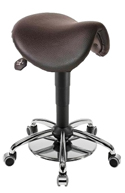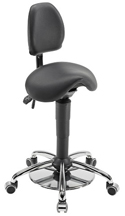| Accessories | | Product Summary |
|---|
The HNDSFREE Saddle Seats from ErgoVerse are ideal for use where seat height adjustments may need to be made while the hands are otherwise engaged. The Foot Release Plate enables quick, easy, hands-free adjustment of the seat height from any point around the chair. Additionally, the straddle position ensures that the feet are well-planted for exceptional stability and upper body control, providing superior upper torso mobility and range of motion. The full 360° of free rotation facilitates easy alignment to patients and equipment or to reach other work areas as needed. The seat can be tilted forward up to 15°, and the gas lift cylinder allows the height of the seat to be adjusted from 24.8" to 30.3", making both models suitable for individuals ranging in heights from 5'7" to 6'2".
Equipped with special braking castors, HNDSFREE Saddle Seats also roll freely when occupied but stop moving as soon as weight is removed. This innovative feature enhances the overall safety of the work environment, and helps maintain focus on the task at hand.
Both models of the HNDSFREE Saddle Seat feature easily cleaned Black Imitation Leather upholstery and a chromium-plated steel base for durability.
Model HSS-B-11209 offers all of the above features, with the addition of a padded, height and angle adjustable back support. The support is 8.5" wide by 10.5" high with a shallow curvature making it suitable for all body types.
The two HNDSFREE Saddle Seat models offer different styles of saddle. The saddle on the standard non-backrest model is a more traditional saddle shape, deeply dished and with overall larger dimensions, especially in the depth. This makes it better suited to those with larger builds. The back rest model has a saddle that is shallower in depth (front to back) and also flatter, making it more suitable to average or smaller individuals or where a more traditional stool height may occasionally be required.
Note: Sitting on a Saddle Seat creates a seating elevation higher than a standard chair. Saddle stools are therefore not generally recommended for use at a fixed-height office desk. Please call one of our Product Specialists to discuss your intended use. We will be happy to assist you in selecting the best solution for your needs. | | Ergonomic Benefits |
|---|
Foot Release Allows Hands-Free Height Adjustment The ability to adjust the height of the stool with the feet facilitates the maintenance of hand hygiene.
Extends Range of Movement Working from the elevated saddle-seat position offers a significant increase in range of motion and greater reach compared to working from a conventional chair or stool. This extends the Comfort Zone and allows access to a larger area of the work surface, while at the same time reducing the risk of overextension. Learn More About the Comfort Zone.
Reduces Risk of Lower Back Pain Standing with the feet flat for extended periods of time (such as at a standing desk or counter) requires the muscles of the lower back to remain in a state of constant tension (even more so if the abdominal muscles are weak.) As the muscles tire, the back tends to curve or arch, which can often lead to an exaggerated degree of lordosis (sometimes referred to as "swayback"). Since some degree of unnatural curvature is already common to many back problems, a standing workstation has the potential to increase, rather than decrease, pain and fatigue. The greater elevation afforded by a stool such as the HNDSFREE Saddle Seat positions the thighs at a downward angle that naturally tilts the pelvis slightly forward. This posture allows the spine to return towards the gently curved S-shape that provides the greatest strength, stability and support for the entire body. The unnatural, extreme curvature is eliminated, and the muscles of the back are able to relax and recover.
Reduces Strain on the Legs and Lower Joints Using the HNDSFREE Saddle Seat significantly reduces stress on the joints of the lower legs. As well, only a small amount of effort is required to transition between sitting and standing fully upright. This transition between stances requires noticeably less effort than rising from a traditional chair.
Reduces Risk of Back Injury The 360° rotation of the HNDSFREE Saddle Seat facilitates easy access to all location within the workzone without straining the back by twisting at the waist.
Reduces Risk of Circulation Problems Individuals working at elevated counters or workstations often prefer to stand, even though static standing has been identified as a contributing factor in the development of edema (swelling) of the lower legs. When the muscles of the lower legs are not active their ability to pump blood and other fluids through the circulatory system is restricted. Sitting on, or leaning against, the HNDSFREE Saddle Seat helps improve circulation by permitting the muscles of the lower legs to freely flex.
Increases Mental Alertness The upright, open core stance provided by the HNDSFREE, combined with the freedom to flex the leg muscles, increases oxygen intake and improves blood circulation throughout the body. This increased cardiovascular efficiency contributes to a greater degree of mental alertness.
Encourages Core Muscle Maintenance The healthy posture promoted by the HNDSFREE helps keep the back and abdominal muscles engaged as they work to stabilize the torso during the work session. This constant, low level activity helps to maintain strength in these core muscle groups without overtaxing them.
| | Features |
|---|
- Foot-Activated Gas Lift: Height adjustment is accomplished via a foot-activated gas lift.
- Tilting Saddle: A simple tilt release lever lets the saddle be tilted forward, a position that may prove to be more comfortable for some. The lower pommel can also make it easier to get on and off the stool.
- Wide Range of Height Adjustment: 24.8" - 30.3"
- 360° Rotation: The full rotation available on this seat makes it ideal for those situations where a worker may need to swivel between work spaces.
- Cushioning Gas Spring: The gas spring that provides height adjustment also serves as a shock absorber to absorb impact as weight is brought to bear on the seat or as positions are shifted throughout the day.
- Easy to Clean: The polyurethane seat covering is waterproof and impervious to most cleaning agents, making the stool a convenient solution in environments where regular cleaning or disinfection is necessary.
- Rolling Base: The size of the base, combined with the wide stance in which the feet are positioned, ensures a stable position. In addition, the casters enable a "push-pull" movement with the feet that lets the stool be easily manoeuvred about the work area.
- Self-Braking Casters: The HNDSFREE Saddle Seat is equipped with special casters that engage a braking mechanism as weight is lifted from the stool. This feature provides greater safety when one is getting on and off the seat by keeping the seat in the same position until it is deliberately moved. The casters roll freely as weight is lowered onto the seat.
| | Images and Multimedia |
|---|

HNDSFREE Saddle Seat
| 
HNDSFREE Saddle Seat with Back
|
| | Technical Specifications |
|---|
| | Usage Tips |
|---|
- Mounting a Saddle Seat. Saddle seats are generally much easier to mount from the rear by swinging one leg up and over the saddle. However, an even easier way is to first tilt the seat forward and then lower it below your optimum seat height before getting off. By doing so it may also be possible to comfortably sit down on the saddle from the front without the necessity of swinging the leg over. Of course, if you have a backrest on your seat mounting the saddle must be done from the front, by backing onto the saddle. This is readily accomplished by simply ensuring that the saddle is lowered and also tilted forward (to lower the pommel) prior to mounting and dismounting.
- Find Your Optimum Height. Saddle seats are designed to support the body's weight evenly distributed over the surface of the seat. Sitting too low will concentrate your weight on a limited surface area of the pelvic bone structure, resulting in pressure points which will be uncomfortable at best. As well, sitting too low tilts the pelvis backward and will cause the back to adopt the 'C'-curve common with standard seats. This effectively defeats the ergonomic benefits of the seat, effectively making it work "against" itself. Appropriate sitting height on a saddle style of seat is with the thighs angled downward at about 45°. This angle naturally tilts the pelvis forward and the back will naturally follow this tilt into the correct 'S' curvature. As well, at that angle the buttocks and thighs are now in contact with the entire seat, thereby distributing weight across the whole surface of the saddle.
- Setting Workstation Height. Saddle seats are generally intended for use where the workstation height can be adjusted to match the optimum seating height. Attempting to work at a station too low will result in you needing to reach or bend down to the worksurface. This will be uncomfortable as the back will try to adopt a 'C' curve while the alignment of the pelvis is trying to move it to a correct 'S' curve. This will most likely result in stress and discomfort in the lower back. The other approach which may be taken is to lower the seat below optimum height (see point above).
- Work at a Compatible Workstation. Ideally you should work at a surface that accommodates the knees and thighs well beneath the surface. Drawers or cupboards will force you back from the desk surface, resulting in a forward-leaning posture that will reintroduces stress in the muscles of the lower back and counters the benefits a saddle seat is intended to provide.
| | Models |
|---|
| For related products, visit our online product listing. | | Model # | Description | Synnex SKU |
|---|
| HSS-11305 | HNDSFREE Saddle Seat with Foot Release.
Formerly sold as Model: 11305 | | | HSS-B-11209 | HNDSFREE Saddle Seat with Foot Release and Back.
Formerly sold as Model: 11209 | |
|
|